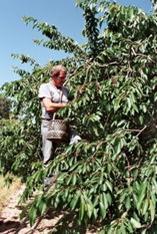
The Picota was first introduced to the UK some 20 years ago and has proved itself a perennial favourite. However, growers recognise the need to strengthen their portfolio, and there is increasing interest in exporting conventional international varieties, selected from as far afield as Canada and Chile, as well as nearer to home from Poland, France and Italy.
Constantine Tierno, managing director of the region’s largest cherry marketing group, Agrupación de Cooperativas Valle de Jerte, estimates that the newer varieties will account for half his sales this season.
The co-operative handles an estimated 70 per cent of the crop, alongside two other groups, the Cooperativa Navaconcejo and the independent Grupo Alba.
The trio are the lynchpin for the 5,000 small growers who grow on plots of an average of six acres.
Early season Van, Summit, and Sunburst are followed by Sweetheart and Lapins, while the Picota crop comes on stream in a slot lasting around six weeks from mid-June to early August.
To date, planted area has remained remarkably steady, mainly because Picotas are fairly fickle cherries in terms of the land they suit, as is evidenced during blossom time when the sides of the valley glow white. So, the new arrivals fit snugly into both the local environment and the region’s production calendar. Whereas Picotas thrive on higher ground and fruit ripens later, new strains open up the possibility of using the lower slopes of the well-watered valley.
“We can plant the new varieties and expect commercial yields in four years,” Tierno says, “which compares to up to 10 years for Picota. So it is another cost saving for growers, and our total season is extended for another month.”
He expects the trend to continue, and forecasts that the balance could change to 60:40 in favour of new varieties, although he shares the view of other leaders in the industry that Picota will always play a major economic role for the entire valley.
Because cherries are notoriously sensitive to weather conditions right up until the time of harvesting, the annual potential 8,100 tonnes is seldom achieved. Over the last five years, tonnages have ranged from 3,900t to 5,800t.
This season unfortunately has been no exception and Juan Reyes, technologist at the industry’s experimental farm at Cabarero, saw the impact of unusually long, freak hailstorms which hit the valley in May, damaging about 40 per cent of the crop.
Picota appears to have suffered less than other varieties though, and the anticipated volume of 5,500t is similar to 2006.
Research and development of new varieties such as Marmotte, Burlat and Starking is throwing up promise, but a key aspect is to enhance Picota. This is mainly being approached through the selection of rootstock that will reduce the size of trees, allowing for easier and faster picking, explains Marcos Manzano, technical director. Some 120 selections are currently being trialled, while work is also being carried out on the use of plastic and netting to protect fruit from weather damage.
“Picota trees have to be regularly topped to keep them manageable, and there are records of orchards staying on full pick for over 20 years,” says Manzano. “Yield per tree is upwards of 100kg.”
This work is rendered more complex by the fact that the term Picota actually refers to five intrinsically different, but similar varieties, all marketed as stalkless as they self seal when picked.
Perhaps the ultimate indication of flattery, according to Fernando Cano, director of the crop’s promotional campaign, is that some other Spanish cherry-growing regions are copying presentation of fruit by removing the stalks by hand. “One added bonus for Picota customers is that, because ripening takes longer, the level of brix which develops is far higher than most other varieties and can reach 16°,” he says.
Fruit also goes though several grading procedures, starting in the orchard, with different categories in 2mm bands ranging from 22-28mm, before it gets to the packhouse. This technology is state of the art, from the critical aspect of removing field heat as soon as the cherries arrive to using water flumes to move the fruit gently along the grading lines that automatically sort to size, colour and remove defects.
On the marketing front, the concentrated Picota promotional programme, funded jointly by the industry, Spain’s government and with some help from the EU, is aimed at Spanish consumers and the primary export markets in the UK and Germany. It has stimulated major retail and consumer interest. Heading the UK customer list are Morrisons, Asda, Somerfield and Iceland.
Run in the UK by Foods from Spain, with a budget this year of in excess of £250,000, heavyweight consumer media coverage in many of the top titles and a presence at the London Food and Wine Fair will back in-store retail promotions. These will include on-pack offers linking with Cava in Morrisons, and a similar approach using Rioja with Asda and Somerfield. Commencing on June 18, and extending across the season, the campaign is targeted to feature on 1.6 million packs.
As for the quality of the fruit itself, “this is not in question,” says Cano. “An added bonus which attracts retailers is our award (in 2003) of a protected denomination of origin (PDO) recognising this unique cherry, which protects its reputation with a guarantee of quality though a rigorous quality assurance scheme and full traceability. “
PDO now covers the bulk of the industry and accounts for 3,668 registered growers and 9,644 hectares.